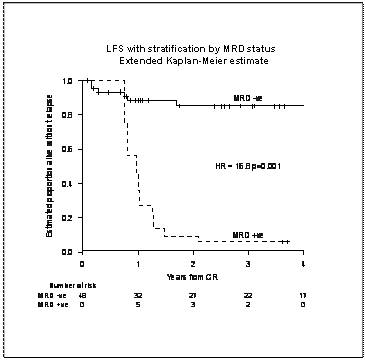Abstract

CBF abnormalities remain a robust prognostic indicator of relatively favorable outcome in AML. Several groups have demonstrated greater responsiveness to HiDAC and studies at MD Anderson established the feasibility of omitting anthracycline when using fludarabine to favourably modulate the intracellular accumulation of cytarabine (Borthakur Cancer 2008). This study further explored that approach by assessing the clinical outcome and molecular responses of patients (pts) treated with fludarabine and HiDAC in the absence of anthracycline.
52 eligible pts with previously untreated newly diagnosed CBF AML were enrolled from 13 centres between 02/05 and 06/09 (protocol registration ANZCTRN012605000152628). One enrolled pt with non-CBF AML was excluded from analysis. Therapy consisted of induction with fludarabine 30 mg/m2/d followed by cytarabine 2 g/m2/d for 5 days (FA) and post-remission treatment with 3 cycles of HiDAC (2 g/m2 q 12 h Days 1, 3 and 5) followed by 3 cycles of FA for 4 days. No patient was transplanted in first complete remission (CR). Quantitative PCR (QPCR) for CBF-specific fusion transcripts was conducted at diagnosis, post induction, post consolidation cycles and 3 monthly during 2 years of post-treatment follow-up. The primary endpoints were failure free survival (FFS) at 2 and 4 years.
Median age was 39 (17 – 62) years. 22 pts had t(8;21) and/or AML1-ETO and 30 had inv(16)/t(16;16) and/or CBFB-MYH11, of which 21 had Type A, 5 type D, 3 Type E and 1 Type G transcripts. CR was achieved in 48 of 52 pts (92%): 2 of 4 non-CR pts were responding (post-induction blast counts of 6 and 7%), 1 had residual extra-medullary disease and only 1 pt had refractory AML. 13 pts relapsed (3 AML1-ETO and 10 CBFB-MYH11 p=0.17; median time to relapse 12.4 (range 9.1 – 25.1) months) and 3 died in CR (sepsis). At a median follow-up of 4.6 (range 2.4 – 6.8) years, FFS was 62% (95% CI 50–77%) and 60% (47–75%) at 2 and 4 years respectively. Overall survival (OS) was 83% at 2 years (95% CI 73–94%) and 78% at 4 years (68–91%) reflecting the relative success of salvage (10 of 13 relapsed pts underwent allogeneic transplant). There was no statistical difference between the 2 molecular subtypes for either PFS (p=0.27) or OS (p=0.5). OS was similar to that achieved in our previous trial (Bradstock Blood 2005) utilizing ICE induction followed by either one further ICE or two IcE consolidation cycles (81% at 2 years). Time to neutrophil recovery (>0.5 x 109/L on 2 consecutive measures) was longer for FA cycles compared to HiDAC (mean 10 vs 6 days; p = 0.001). The rate of grade 3,4 infection was high (88% of pts had at least 1 episode) with 17% coming off protocol for toxicity and only 29 pts (56%) completing all 6 cycles of post-remission therapy with no difference in cycles received between pts who relapsed and those who did not (median cycles delivered was 6 in both groups). Detectable QPCR levels in remission were significantly associated with risk of relapse (10 of 13 relapses were preceded by MRD positivity at a median of 13 weeks; p=0.001). All 10 patients with levels >250 copies in PB or BM at any post induction time point subsequently relapsed. LFS was significantly different for patients with MRD positivity (>10 copies on 2 consecutive measurements or >250 at any time) during follow-up compared to those who remained negative (Fig 1). Multivariate analysis did not identify any significant associations between recognized clinical variables and either PFS or OS. LFS was not associated with c-kit mutational status for the subset of 33 pts with results available (p = 0.6).
The high CR rate and relatively favourable FFS and OS of pts with CBF AML treated with non-anthracycline containing fludarabine-modulated HiDAC based therapy, are similar to published results achieved with standard anthracycline combination treatments. Short-term infectious toxicity of this regimen, particularly during the prolonged post remission therapy, remained significant and the lack of association between relapse and number of cycles delivered suggests the duration may be shortened. QPCR monitoring was confirmed to be clinically useful in the prediction of relapse. Results will be updated after the planned final analysis.
Off Label Use: Fludarabine in the treatment of AML.
Author notes
Asterisk with author names denotes non-ASH members.

This icon denotes a clinically relevant abstract


This feature is available to Subscribers Only
Sign In or Create an Account Close Modal